If you have a little one, you already know preschoolers love to move, explore, and make noise! They are learning by exploring and experimenting. Attention spans are limited, and music lessons that insist on simply sitting still and listening will likely fail. Kids this age learn best by involving their bodies and moving. I’ve taught ‘piano’ to students as young as 3, but these lessons were filled with movement activities. You can easily do many of the same activities with your own kids at home!
This post may contain affiliate links, which means I receive a small commission, at no extra cost to you, if you make a purchase using the link. See the full disclosure for more information.
What are Music & Movement Activities?
Music and movement activities let preschoolers explore music through movement. They use their bodies, simple rhythm instruments, and large movements. This is ideal for learning music at this age and gives 3-5 year olds a chance to experience music, and rhythm in age-appropriate ways.

Why are Music & Movement Important for 3-5 Year Olds?
Gross motor skills
Movement games involving tapping and clapping help children develop coordination. They also develop an awareness of their bodies and personal space. Music and movement activities also help little ones build the foundation of motor skills for life skills like tying their shoes.
Creativity
Kids enjoy moving creatively and exploring sounds. Music and movement encourage imagination. For example, kids might imagine and creatively act out an animal while listening to classical music. Encouraging creativity helps kids develop problem-solving skills as they get older.
Preparation for later music lessons
Similar to language skills, this is an ideal age to start learning music by listening to it and imitating sounds. While reading music doesn’t happen any faster if you start at the preschool level, preschool children who have a music education will have a strong basis for music lessons later. They also often develop a strong sense of rhythm more easily than children beginning at an older age.
Listening skills
Musical movement games usually involve listening to and following directions. Children will also be actively listening in action songs and games. Building these skills before they are in school with fun music games is a great idea!
Social skills
In group settings, 3-5 year olds will learn to work alongside others and respect each other’s physical space while they are moving about. They also learn to cooperate and listen to each other. For example, when participating in a circle song or game, or when they are clapping, tapping, or singing in time together.
Tips for success
Open-ended activities are a great idea at home where children can explore and learn informally. Let them be creative and experiment with music, movement, and making sounds. More structured activities will be most successful for 3-5 year olds when they are well planned, flexible, and short.
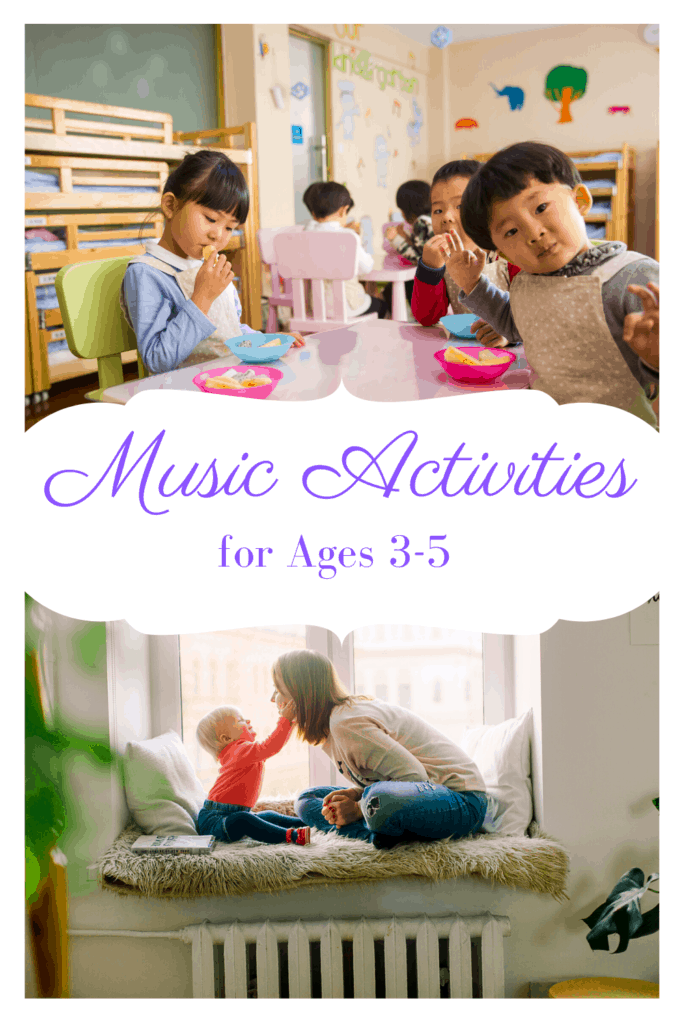
Activity Ideas for Preschool Music and Movement Activities
Below are 7 music & movement activity ideas for you to try with your preschooler. 3 year olds are very different from 5 year olds, of course, so adapt the activities to your child.
Shakers
I think shakers are the best instrument for the youngest kids. They are easy to grasp and keep hold of, and they don’t need a high level of coordination to get started. Preschoolers will enjoy shaking along to the music, or holding them while dancing to create more noise. They can begin to follow the beat with their shakers, and also use them for the other activities below
Other rhythm instruments
Most rhythm instruments are a good fit for children by age 3 or 4. Fun options include small drums, jingle bells, or rhythm sticks. Let your children explore the different sounds and create their own music. Or use them to follow the beat in a simple song.
A fun example is to adapt ‘ The Ants Go Marching’ song for rhythm instruments to sing: ‘The sticks go tapping’ or ‘The bells go jingling’. The song has a strong beat and an easily learned melody with repetitive words, which are all good at this age. Preschoolers love repetition with small changes, such as the same song with a new motion or action.
Free movement & Dancing
Scarves and ribbons are a lot of fun to use as props for 3-5 year olds. Be sure to supervise of course, especially for the youngest ones.
Encourage your children to listen to the music and act out how it sounds. For example, if you played ‘The Skating Waltz’ (by Emile Waldteufel) they could glide around the room waving their scarf slowly in the air. Maybe they would pretend to be a princess or a ballerina, but probably not a dinosaur!
You could listen to ‘Flight of the Bumblebee’ (by Rimsky-Korsakov) and pretend to buzz around the room quickly. Perhaps another piece of music would encourage slow and heavy stomping like a dinosaur.
Motion songs
Sing action songs with your children, or play them from YouTube or your favorite playlist. Some of my favorite action songs are:
- ‘The Hokey pokey’ – this such a fun activity for kids, and will lead to lots of giggles! It also teaches about the body and awareness of space while moving your body.
- ‘Wheels on the bus’ – This can be sung and acted out. It’s also fun to substitute the words. For example sing ‘The feet on the bus go stomp, stomp, stomp ‘ or ‘hands go clap, clap, clap’ or ‘noses go beep’. Encourage your kids to be creative and come up with some more ideas!
- ‘Ring Around the Rosie’ and similar circle chants with actions are also a good fit for preschoolers. Although they are great for larger groups, you can still do these songs with as little as just 2 people at home with your child.
- ‘Teddy Bear, Teddy Bear, Turn Around’ – rhyming song
- ‘I’m a Little Teapot’ action song
Freeze dance
You’re probably familiar with the freeze dance game. You play music for everyone to dance to, and they must freeze when the music goes off or be out. This game is a great movement break from other activities to get kids up and moving to some tunes.
Imitation
Imitation and copycat games help develop listening skills and rhythm. For example, you could play Simon Says’ using rhythms. If your children have shakers you could say ‘Simon says shake up high’ and then shake a rhythm for them to copy. Have fun with very simple rhythms, clapping them, singing them, or even tapping them on your nose!
Marching
Marching encourages children to feel the beat and rhythm of the music. Let your child create their own musical instrument. A maraca, shaker, or drum are all simple ideas you can make from things you have around the house. For example, a coffee can and wooden spoon drum, a plastic egg shaker, or a toilet paper roll taped closed and filled with beans.
Find some marching band music on YouTube or play your favorite children’s songs with a strong beat such as ‘The Grand Old Duke of York’. Your preschoolers can march along to beat with their new instruments and have a parade!
A favourite resource for rhythm instrument activities for preschoolers
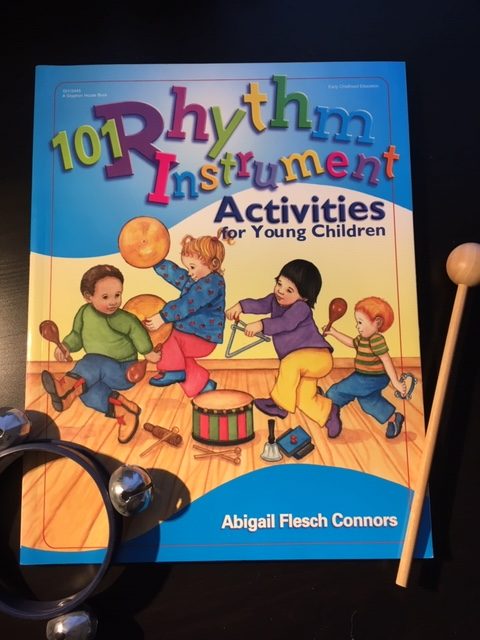
I’ve had some questions about more resources for music and movement activities for 3-5 year olds, especially using instruments. (If you’re interested in preschool piano I have some relevant posts) But, more relevant to this topic, are rhythm instrument activities. Rhythm instruments give preschoolers the opportunity to move their bodies while developing motor skills and making music.
My favourite resource for rhythm instrument activities (practically an encyclopedia of familiar songs, movement rhymes, and games) is a book I’ve had for quite a few years: 101 Rhythm Instrument Activities for Young Children by Abigail Flesch Connors. I’d suggest this book especially for preschool teachers, or anyone in early childhood education wanting to incorporate more music and movement activities.
Music and movement activities with your preschooler
Music and movement activities are the perfect way for 3-5 year olds to experience music-making. They benefit both your child’s physical development and their learning. These are simple activities for parents to do at home with their kids and would be easily adaptable for preschool teachers as well.
What music activities does your preschooler enjoy?
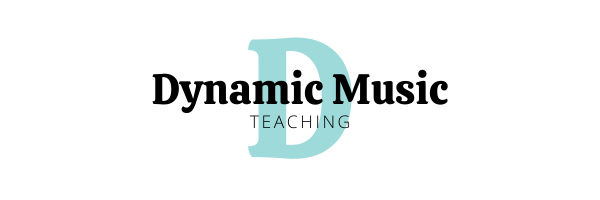
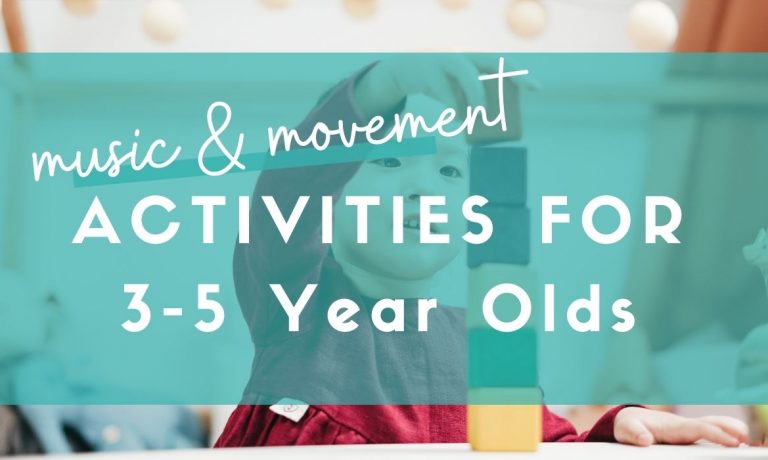
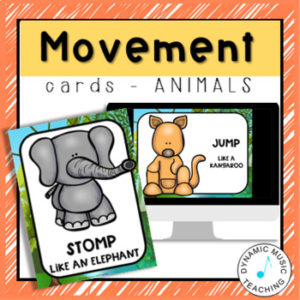
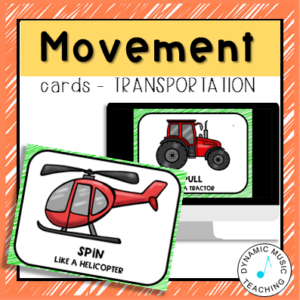
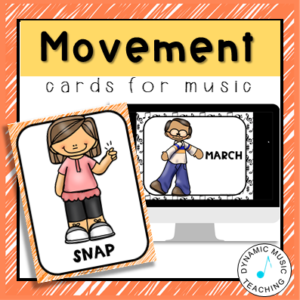


8 Responses
Can you email me some more ideas for art, music and movement activities for 3-5 year olds. Thank you
I’d be happy to – thank you for taking the time to read my blog. I’m afraid I don’t currently teach art, but focus on music – although there are many, many sites with excellent ideas for art with 3-5 year olds. One of my favourite music activities for preschoolers that also incorporates movement is to use rhythm instruments or body percussion along with repetitive songs or rhymes. I have an excellent book I use for the preschool age range called ‘101 Rhythm Instrument Activities for Young Children’ by Abigail Flesch Connors. I have had it for years. Movement cards are also a lot of fun for ages 3-5. They can be done with music (for example to practise a steady beat) or without. Here are a selection of printable movement cards available to purchase. I also have a free printable set of movement cards on my free music resources page. I hope that helps!
Musical instrument activity for 3-5 years old. i need visual art too
Thanks for reading! If you’re looking for a great resource for musical instrument activities for 3-5 year olds, I’d suggest checking out ‘101 Rhythm Instrument Activities for Young Children’ by Abigail Flesch Connors. It’s my go-to resource for songs, rhymes, and games for preschoolers using rhythm instruments (shakers, sticks, drums, bells, etc.). I’ve had this book for years, but will see if I can find a link to add to this post since it might be helpful to others as well.
I don’t teach visual art, so I can’t help there, but I know if you do a google search you’ll find some excellent resources.
Hello.
I teach piano, and have a mom who wants her 3-yr-old to learn. After several tries I have recommended she wait another year or two with him. She still wants me to try. I am currently trying to adapt how I teach my 5’s, but could use some other ideas. Couldn’t find your posts about that. ????
Thank you so much for visiting my site! I have 2 posts about preschool piano meant mostly for parents wanting to try some piano learning before committing to lessons:piano by color and activity ideas for learning the keys
However, if you’re a piano teacher, I have a few more suggestions that might help. Keep in mind just turned 3 vs 3 1/2 say, are quite different development-wise. I have taught older 3 year olds using the ‘My First Piano Adventure’ book A by Faber. I don’t think it would work well for younger 3 year olds though. I do highly recommend the books called ‘Wunderkeys Piano for Preschool’ by Andrea Dow. They are designed with 3 year olds in mind, and should work for your student. They are available on Amazon, and created by the lady who blogs on ‘Teach Piano Today’.
I hope that help, I’d love to know if this works for your student. Teaching 3 year olds even with a good program, is a challenge for sure, and takes a lot of patience. Take care, Katharine
i really love the actvities.